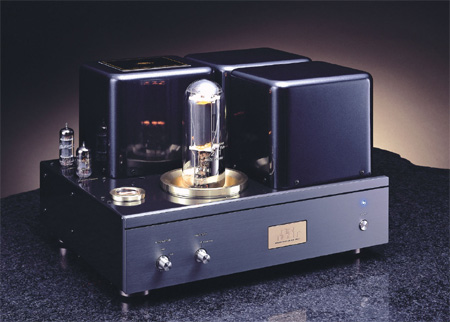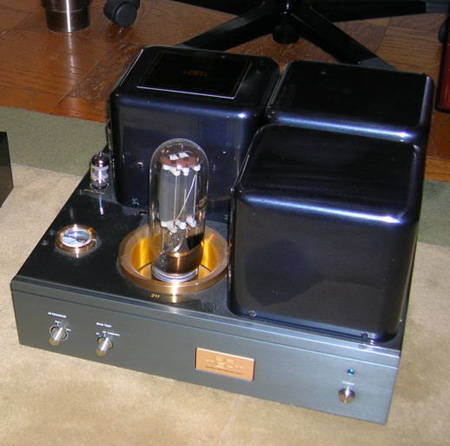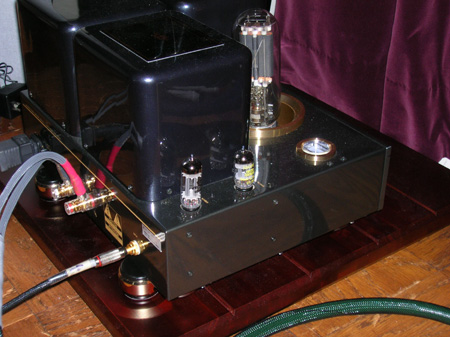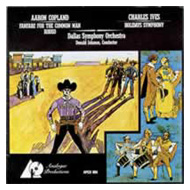|
Revealing the organic truth in music. Hand crafted in the U.S.A. Fine artisan-built analog, digital, loudspeaker, power, and video cables featuring ultra-pure Cryo-Silver™ deep cryogenic treated 99.999% solid silver conductors, Big Air™ dielectrics, and Ceramic Micro-Sphere Conduit™. Visit us at T.H.E. Show 2006 Las Vegas St. Tropez Hotel, Suite 2808-2810 (next to the Alexis Park's CES exhibits) |
You are reading the older HTML site
Positive Feedback
ISSUE
22
air tight
ATM-211 amplifiers
as reviewed by Marshall Nack

|
MARSHALL NACK'S SYSTEM
LOUDSPEAKERS
ELECTRONICS
SOURCES
CABLES
ACCESSORIES
|
A Quiet Company
While everybody's heard of Air Tight and their products are well respected, nobody seems to know much about the company. They're a bit of a mystery. They don't advertise much (at least not in the USA), and they rarely are reviewed. New products don't come out that often—the latest amp, the ATM-211, was introduced four years ago. When I confirmed its trajectory's imminent arrival at Nack Labs, I went looking for info. Nuh-uh, not much to be found. The company doesn't maintain a web site and neither the U.S. importer nor any of its retailers mention the 211 on theirs. Talk about keeping a low profile!
I did come upon the following history at a retailer's site: "Air Tight is the brainchild, and long-cherished dream, of Atasushi Miura. His father, who began by building transformers for the budding Japanese audio industry back in the '30's, was the head of Luxman Corporation, a manufacturer of fine audio equipment with worldwide recognition for their high quality sound and construction. To this day, among the audiophiles who remember it, the original Luxman line is still spoken of with a certain amount of reverence. Thus, Mr. Miura was "born" into audio. Under his father's guidance, he worked his way through the company, attaining the status of audio engineer, designing the circuits for many of the famous Luxman tube amps. The company grew and, eventually he took over the reins at Luxman."
"In the mid-'80's, Mr. Miura began sensing a shift in the audio industry toward lower quality components. Rather than become part of the slide into mediocre, mass-market products, he decided to sell off Luxman (to Alpine) and start his own new company, Air Tight." (Credit: The Tweak Shop.)
The ATM-211 commemorates Air Tight's 15th anniversary.
Power is good; Absolute Power is…
When the product arrived, I was finishing up my Survey of Select SET Amplification, wherein I compared four low-powered SET amps (around eight watts or so). This was a perfect transition—the ATM-211, with its 22 watts, belongs in a higher power classification, and is also a SET. Members of this class, the most famous being the 18 watt Lamm ML2, occupy a midpoint between the single-digit-wattage guys and push-pull tube designs. Their mutt-like personalities reflect this pedigree. Imagine them possessing a touch of the sweetness and warmth of the one, with a lot of the resolution and dynamics of the other.
I first mated the 211s with the fuel-efficient Hørning Agathon speaker, which I had become acquainted with when tethered to the four low-powered amps in the Survey. This transducer only requires a watt or two to produce room-filling SPLs and room-quaking low-end wave fronts. Now, with more power available, the Hørning Agathon shed its outer skin and morphed into a new personality. Its voice became more coherent, its disappearing act more complete. Compared to any of the low-wattage SETs, the soundstage it threw with the 211s was a different experience, as different as day is from night. First of all, images were smaller, sized like you'd get from many higher-powered amps. Borders were sharply defined and there were spaces between instruments. Secondly, the images were arrayed in firm and unwavering locations upon a bedrock-like foundation. Finally, the sheer density of those images was something to behold. The combination of those three ingredients conjured an image of a Japanese commuter rail car during rush hour. Alternatively, it reminded me of a topographical map, with its two dimensions that attempt to convey 3-D. The listener will find this an important aid in making sense of complicated passagework, as it lays out each player's discrete contribution to the overall composition.
This is an amp with a very strong will. The density and solidity of the stage before me left no doubts on that score. Its exceptionally wide dynamic range cemented the impression. The ppp side of that range sinks into deep quietude, assisted by an undetectable noise floor from the listening position. Many things are going on during those quiet passages. Low-level dynamics had vitality just like the fff sections—unusual, to say the least; most amps lose their spunk when the signal gets low. So, you relax. Hey, you are being set up. For once a stronger signal comes along you will be rudely jolted out of your reverie and instantly at attention. The 211s do zero to sixty in blitz time. (By the way, don't confuse wide dynamic range with the ability to play loudly. Some people think loud is the same as dynamic—nuh-uh. Dynamic range is the difference from min to max SPL at a given volume setting, a very different thing from a continuous ear-splitting SPL.
A little unexpectedly, for an amp with such dynamic wallop and resolution, the purity level was quite high in the way that SETs manage to do this. There were few audible distortion products and an overall touch of sweetness and warmth. Articulation also shared similarities to the SET model, in that the life of the note was fully expressed—its launch, duration and end. A lot of push-pull gear blurs the point where one note ends and the next is launched, so you never get to hear a clean ending. The 211 finish was cleanly demarcated, maybe even a little exaggerated. Things happen faster and more crisply. It strikes me that maybe everything I've said so far is related—it all comes back to that strong will. This is responsible for it all, even the high purity. You don't imagine purity happens by accident or neglect, do you? A guardian is required to shepherd the fragile signal en route, making sure it stays out of harm's way, identifying and warding off contaminants (sins of commission). At the same time, the integrity of the signal must be respected to make sure it arrives fully expressed (sins of omission). Willfulness, or control, is necessary to safeguard it. I'm reminded here of what I wrote about the Lamm ML1.1 a while back—another outstanding performer and a willful one in the same way. However, there the similarities ended, for these two amps did not sound alike. The ML1.1 is a push-pull tube mono-block amplifier with 80 watts/channel.

Those three imposing transformer cans probably have a lot to do with the willfulness of the 211. Each can is about as big as those on the ML1.1, but the Lamm only has two. Given that the Air Tight plinth is much smaller, the cans consequently take up three quarters of its surface. They are huge, each one looks like the entire allotment you might find on many other amps and, unlike the ML1.1s, they are dead silent—a knuckle rap on any surface merely served to damage one of your digits.
But mostly the strong will is evident in the density of images and their precise, locked-in specificity. Everything is tighter. The ATM-211s do exactly what the company name suggests—they make the Air Tight(er). (Heh, heh, no doubt you're thinking this is cute and obvious. Nevertheless, while true of the ATM-211s, I have no idea if it applies to other Air Tight products).

Since the 211s went in, it seems all I listen to is Wynton and his brothers. I made the point in my TAOC Component Rack review that one tends to play musical fare that shows off the system to best advantage. So it was that I found myself enjoying many Lincoln Center Jazz Orchestra recordings. Twenty-two watts into the 100dB sensitive Agathons gives you dynamics and bass control you wouldn't believe.
Curious, I'm now looking straight out at Wynton Marsalis, who is standing at eye-level and dead center (Selections from The Village Vanguard Box, Columbia CK 62191). Eric Reed's piano is at the same height, a little to the right. The stage has the same width, the same depth I'm used to, but it got taller. Feels funny to have everyone on this virtual stage, elevated off the floor, all at the same height—all that weight and power and no one touching terra firma.
Let me describe the scene from track 11 of Selections. The action begins with the bass drum down center, large and tight, exciting the snare, so its little filigree details in turn describe the space around it. The tambourine in deep space down left radiates enough cues for you to differentiate soft palm strikes upon it. Wynton's trumpet and the sax (tenor or soprano—I can't tell which) down center, are a little to the right of the bass drum. The sharp transients from Herlin Riley's rim shots stay completely away from the rounded action of the playing going on elsewhere. Wow, it's most impressive how the amps keep the integrity of all these events intact. This is the kind of stuff the 211s let you discern with no sweat—the tough part is in putting it down on paper. They dished up the smallest events, and made them more prominent in the way they delineated images.
Half way through the audition, I switched to my Kharma CRM 3.2 speakers. I now experienced such dynamic swings, at first I thought it verged on exaggeration. Not to mention a frightening level of resolution, speed and focus, with a perfectly believable timbre. Coming as it did after the Hørning Agathon, there was just enough warmth and flesh to make it credible, and no more. (I didn't have one on hand, but I imagine a fully tubed pre-amp would have made up the difference in body). The soundstage layered off into a focused and very deep space and was seamless across its width, set a little further back, some feet behind the speakers. Instruments had a more forward projection; they reached out to you in a front to back, or depth, sense.
Sound Pixels
This level of resolution with the CRM 3.2s is something I haven't heard in a good while (I can't even remember when, or if ever) and it extended down to the minutest details. I was getting a sense of the texture comprising sustained notes. This is something you always hear in good concert halls. If you hone in on sustained notes, blocking out everything else, and just concentrate, at first they seem to be smooth, period. Listen a little longer and deeper. You begin to discern tiny differences. Then you realize a very fine texture is present within the smoothness. This level of minute differences is what I like to call "sound-pixels". The vast majority of tube gear will recreate this as a bland, textureless expanse, while the grain structure of solid-state gear, being larger and coarser, voids it entirely.
I now had the first signs of a shape, a form, of something happening in that smooth, homogeneous sustain. Wycliffe Gordon's trombone begins with the jagged, rough, mid-rangy leading edge you expect, but the following bell tone, while smooth, exhibits some of this texture. (By the way, many folks expect the trombone transient to reside in the treble band by virtue of its brittle metallic edge: not so). Then, when he modulates, the transient is again jagged and detailed. The only amps I've heard render "sound-pixels" like this are from Lamm—the ML1.1 mentioned above for their strong control, and ML2 tube mono-blocks, which are still champs in this capacity. (While we're on the topic, let me add that I consider the ability to get down to this nitty gritty level one of the hallmark differences between analog and digital. The finest micro-textures available from analog escape even the mighty DCS Stack.)
 And not just jazz. A splendidly dynamic LP from the
days of yore that I haven't spun in quite awhile is the Analogue Productions
reissue of COPLAND: FANFARE FOR THE COMMON MAN. RODEO. IVES: THE FOURTH OF
JULY (APC 004). Recorded in 1967 by David Hancock for the Vox Turnabout
label, the dynamic range on FANFARE always sent shivers down my spine, in no
small measure from fear of one of my speaker drivers giving up the ghost under
the strain. Well, you should hear it now, with the 211s goosing the Agathons.
Tremendous transient kick and power, and not a hint of distortion. Plus great
clarity and stability of the instruments arrayed on the virtual stage. The lack
of extraneous sounds helps reveal the rhythmic elements of the performance. I
tell you, I'm amazed my analog front-end is this good, let alone the downstream
components. Ah, but there is a downside: one also easily perceives that the
Dallas Symphony Orchestra doesn't quite have it together. There are better
performances on record, if not better sounding ones. Moreover, my past
impression that this LP is a bit on the thin side is affirmed.
And not just jazz. A splendidly dynamic LP from the
days of yore that I haven't spun in quite awhile is the Analogue Productions
reissue of COPLAND: FANFARE FOR THE COMMON MAN. RODEO. IVES: THE FOURTH OF
JULY (APC 004). Recorded in 1967 by David Hancock for the Vox Turnabout
label, the dynamic range on FANFARE always sent shivers down my spine, in no
small measure from fear of one of my speaker drivers giving up the ghost under
the strain. Well, you should hear it now, with the 211s goosing the Agathons.
Tremendous transient kick and power, and not a hint of distortion. Plus great
clarity and stability of the instruments arrayed on the virtual stage. The lack
of extraneous sounds helps reveal the rhythmic elements of the performance. I
tell you, I'm amazed my analog front-end is this good, let alone the downstream
components. Ah, but there is a downside: one also easily perceives that the
Dallas Symphony Orchestra doesn't quite have it together. There are better
performances on record, if not better sounding ones. Moreover, my past
impression that this LP is a bit on the thin side is affirmed.
Then one of my old favorites, Guitar Concertos (RCA Living Stereo LSC-2487, original Shaded Dog pressing), caught me off balance. The Melos Ensemble accompanying Julian Bream was flawless, perfectly defined with good timbre and excellent weight. However, an astute visitor, who happens to be a classical guitarist, made the observation that Bream's guitar down center stood apart in a different acoustic space. Furthermore, it was lacking the body resonances one expects from the acoustic instrument—you only heard the trebly pluck of its strings—where was the wooden body? Hmmm, we speculated about the possibility of spot miking or bad engineering choices. Needless to say, I've never heard that before. A nifty bit of resolution there.
Next, we come to another splendid LP, DEBUSSY CHAMBER MUSIC with the Athena Ensemble (Chandos ABR 1036). Brian Couzens recorded this one in 1979 for inclusion in the Chandos Super-Analog series. Yes, the clarity, solidity, and resolution are quite present, but there's also ease and flow on this "wet" recording. Instrumental timbre rings full and true. I especially like the way the viola sound is captured on the Sonata for Flute, Viola, and Harp, frozen in time for us to enjoy forever. The flute does it for me; the harp does it for me.

There is an unusual duet for organ and bass-trombone on track four of Vivaldi: Motets (Virgin Veritas CD, 4570 2), with Fabio Biondi's Europa Galanté and soprano Patrizia Ciofi, a good selection for revealing low frequency quality and resolution. The bass-trombone is further back, well behind the right speaker, and its image has begun to separate from the large, centrally located organ. Everything is like that, lined up and discrete—except for Patrizia, whose voice is wild and unruly, very hard to localize (but still more defined than previously). Her crescendos run wild like free-range turkeys, over an enormous dynamic range, with top notes that have always evidenced break-up. And they do so now. The 211s are not indulging in any covert cover-up activity. What I mean is, they don't indulge in that soft clipping disguise of the single-digit amps which smoothes over break-up. By the way, Fabio's silken violin is rather gorgeous.
Impressions
So, here we have a SET that moves the portrayal towards neutral. Most people will connect with the 211s' perspective and have no trouble relating it to what they experience at a live event. They place you into the hall from the point of view of an audience seat. The performers are definitely in front of you, some distance away, and on a stage. It won't be jarring to come home to after an evening at the symphony or the club. In addition, the 211s performance at the frequency extremes is nothing like the average low-wattage guy, not to mention its evenhanded midrange. The frequency spectrum is doled out proportionately, balanced slightly higher up in the midrange than most of the eight-watters; consequently, it's a little brighter sounding. Bass is big, round and damn near as tight as a tube amp gets. Overall, it's warm, if less so than the single-digit guys. The beauty and emotion—the soul factor—are doled out more modestly; the emotional content and intimacy are kept in check. The only issue is that the treble is thinner than the rest—otherwise, body is good. Occasionally treble peaks get pointy while the rest is rounded. Still, the treble avoided roughness.
There were some visitors who couldn't get enough of the ATM-211s paired with the Agathons. One fellow described it as a "precision sound" and proclaimed it the sonic Holy Grail. No dissent from this quarter on that description. But it wasn't everyone's cup of tea. An equally sizable group felt it was too locked down. They found it stiff and complained the 211s grip was too tight. They missed the flowing line, the organic, dancing qualities. Let's put it this way: what it did was more neutral, and it did it extremely well.
Break-in and Housekeeping
Beautifully made, from the confidence-inspiring metal well holding the giant 211 tube's socket, to the solid copper plate covering the bottom, the 211 has clean lines and apparent Zen-like simplicity—all fussiness and excess is avoided. The interior appears to have very clean point-to-point wiring. Front controls include push-button on/off. Push the power on and the blue LED starts to flicker. A countdown relay is activated and in about one minute, you're good to go. Next to that is the Bias Check Meter switch. Inputs are provided for single-ended only, with one set of WBT speaker binding posts.
The 211 tube is big, about the same size as the 845, to which it bears more than a passing sonic resemblance. Both throw almost enough light to read a book by, and generate enough heat to be a factor in your monthly power meter readings. The ATM-211 features Class A operation, no negative feedback, and direct-coupled cathode follower/driver tubes for high power. The amp-stage, bias, and heater relay are each independently wired with Tamura transformers.
Setup was a cinch. To set the 211's bias, flip the front panel Bias Check Meter switch and a meter on top lights up. Your job is to get the needle into the sweet spot by applying a screwdriver to a setscrew accessible from the top. I set it when they were installed, and then checked it twice over the course of several months—no further adjusting was needed. With these amps, you set them once and then forget them.
Each 211 mono-block has an attenuator, which gives a full sweep of volume from off to max. This can be used to balance the amplification duties between the amp and linestage. In other words, with the 211 attenuators all the way up, the pre-amp volume would be set way down—and you'd be hearing mostly the amp. I wanted to see how the sound changed with the amp more or less dominant. Cutting back the attenuator, so the pre-amp had more to say, the sound got drier, duller. Open it up all the way and you get the amp's tonal/timbral quality, which I thought very much in the zone—and a taste of SET emotion and liquidity flood back in. At the max setting, the 211 has a lot of gain, requiring the TRON Syren pre-amp volume turned down to around 2 or 3 out of a possible 10. (BTW, I also had to drop the ground on the amps when the Syren was used.) With the von Gaylord Audio L3 line stage, the volume needed to go down to about 8 o'clock. I must say, with the vGA L3 and the 211 set like this, driving the Kharma 3.2s, I was getting dynamics and speed I couldn't believe—setting a new standard in my room. The 211s rarely showed the strain—there was minimal overloading or distortion on peaks, and when it did happen, it was the soft clipping that tubes do.
I situated the 211s right where most amps wind up, on a pair of TAOC Sound Create Boards or Harmonix TU-888 System Tuning Boards. After I got familiar with them, I threw a set of Harmonix RF-66ZX footers under ‘em to add a little more warmth and loosen them up.
Conclusion
The character of the Air Tight ATM-211 SET mono amps can be described as hugely dynamic, possessing high definition and notable speed. They throw a rock solid, tightly woven, and excellently described soundstage. A great deal of control is evident—you might call them strong willed. This is most evident in the clarity, density, and unwavering placement of images on the soundstage, but also in their tight grip over the abundant low-end. Plus, they have some of the high purity quotient and sweet tone associated with the SET topology.
Weighing all of these, the ATM-211s, while residing power-wise in the mid-ground between push-pull and the single-digit wattage SETs, seem closer to the former. The ATM-211s have many of the better qualities of powerful tube or even solid-state gear. They are the best of all the SETs I've tried in terms of dynamics, image stability, speed and bass control. They have little of the usual tube amp downsides—operation is quiet, there's no tube rush and. while they sound warm, they're not loose (far from it!). Treble is extended, if a little thinner than down below. And like the better tube amps, there is a total absence of any electro/mechanical signature. The 211s credibility was assisted by their real-life, concert-hall perspective. This guy is rather neutral and communicative. If he doesn't capture you on an emotional level, he will certainly entertain you intellectually.
The 22 watts of the ATM-211 were a dynamic shock after listening to eight-watt SET amps. With everything else equal, the 100dB sensitive Hørning Agathon speakers were transformed. Directed by the ATM-211s, they assumed the air of a precision instrument. With the 89dB Kharma CRM 3.2s, their resolving power, and again, the dynamics flabbergasted me.
Don't be fooled by the 22-watt power rating. Dynamics were excellent into moderately sensitive speakers. If you're used to high-powered tube amps, you'll probably find the ATM-211s are up to the mark. And they'll sweeten the ante with a taste of the magic only SET devices afford.
ATM-211
mono amplifiers
Retail: $13,000/pair
-
Tube complement: one each: 211, 12AX7, 12BH7A
-
Power output: 22 watts
-
Dimensions: 390W x 360D x 260H mm
-
Weight: 26 Kg
Importer information
Axiss Distribution, Inc.
17800 S. Main St., ste 109
Gardena, CA 90248
TEL: 310. 329. 0187
email address: [email protected]
web address:
www.axiss-usa.com

